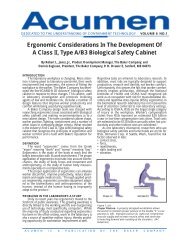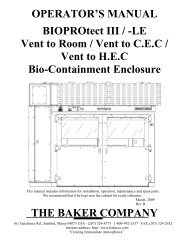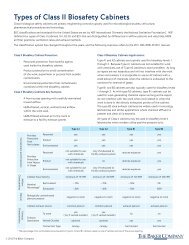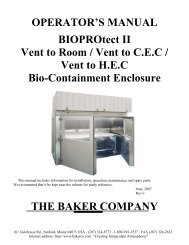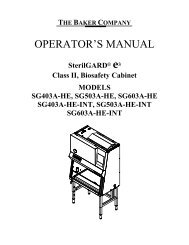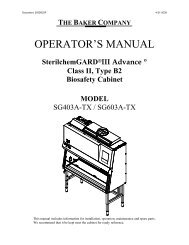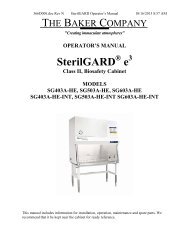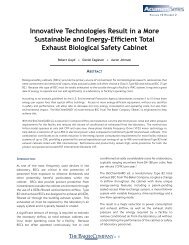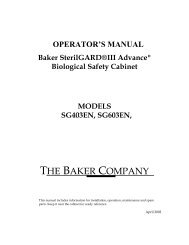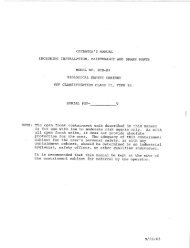OPERATOR'S MANUAL BIOPROtect II JR Vent to ... - Baker Company
OPERATOR'S MANUAL BIOPROtect II JR Vent to ... - Baker Company
OPERATOR'S MANUAL BIOPROtect II JR Vent to ... - Baker Company
You also want an ePaper? Increase the reach of your titles
YUMPU automatically turns print PDFs into web optimized ePapers that Google loves.
Maintenance Notes<br />
Replacing the HEPA Filter<br />
WARNING!<br />
Before any panels are removed, the cabinet must be decontaminated. The filters are sure <strong>to</strong> have<br />
collected microorganisms and other potentially harmful particles generated from the work area during<br />
their lifespan. Maintenance personnel should not allow themselves <strong>to</strong> be exposed.<br />
It should also be remembered that a specific gaseous decontaminant may work against<br />
microorganisms, but not against chemical agents. Where chemical agents are present, consult an<br />
industrial hygienist or other qualified person(s).<br />
If the differential pressure moni<strong>to</strong>r presents an alarm, or if your periodic checks of <strong>to</strong>tal airflow show a<br />
drop of more than 5% of the nominal set point, the filters may be loading with particulates. As explained<br />
earlier in this section, the blower speed can be manually increased <strong>to</strong> compensate for filter loading.<br />
However, when the airflow can no longer be maintained or when the filters are damaged, they need <strong>to</strong> be<br />
replaced.<br />
A contaminated filter must be handled with caution. Personnel should be protected by clothing or<br />
breathing apparatus as necessary <strong>to</strong> the nature of the hazard. It is advisable <strong>to</strong> seal the contaminated side of<br />
the filter by taping a plastic sheet or cardboard over the face before removal. This should minimize the<br />
number of particles shaken loose from the filter. Once removed, the filter should immediately be sealed in a<br />
biological hazard bag and then disposed of safely in accordance with environmental regulations.<br />
After filter replacement has been completed, the cabinet and the room should be cleaned and<br />
decontaminated in a manner consistent with the nature of the hazardous material. The cleaning materials,<br />
along with the protective gear and clothing, should be properly disposed of.<br />
HEPA filters are very easily damaged, and you will want <strong>to</strong> use great care during handling so as <strong>to</strong> avoid<br />
injury <strong>to</strong> the filter media and gasket surface. When installing the new filters, it is a good idea <strong>to</strong> tape a piece<br />
of cardboard over the filter media <strong>to</strong> give protection against dropped wrenches or misdirected fingers. Of<br />
course, you will need <strong>to</strong> make sure that the cardboard is removed before the access panels are re-installed.<br />
Inspect the filters carefully before and after installation. A broken or damaged filter is worthless.<br />
Changing the Exhaust Filter<br />
The <strong>BIOPROtect</strong> <strong>II</strong> <strong>JR</strong> requires one exhaust filter measuring 19” x 38” x 12” deep (consult test report<br />
for part numbers and specifications). This filter is arranged <strong>to</strong> face the front of the unit so as <strong>to</strong> eliminate<br />
the nuisance of ceiling restrictions on the exhaust air.<br />
To service the exhaust filter remove the panel from the front of the unit using a 3/8” nut driver or<br />
socket <strong>to</strong> remove the ¼-20 hardware. Using the same 3/8” driver, remove the hardware from the filter<br />
securing frame. Pull the frame and filter away from the unit.<br />
Prepare the new filter by putting a light coat of silicone grease on the face of the gasket. Clean the<br />
sealing flange thoroughly. Then carefully slide the new filter in<strong>to</strong> place and make sure that it is properly<br />
seated on the flange. Replace the filter clamp assembly and perform the leak test described earlier in this<br />
chapter.<br />
http://solid/prereleased/prereleased/STAN. PRODUCT/313/DOCS/313D000.doc<br />
Page 22 of 59



